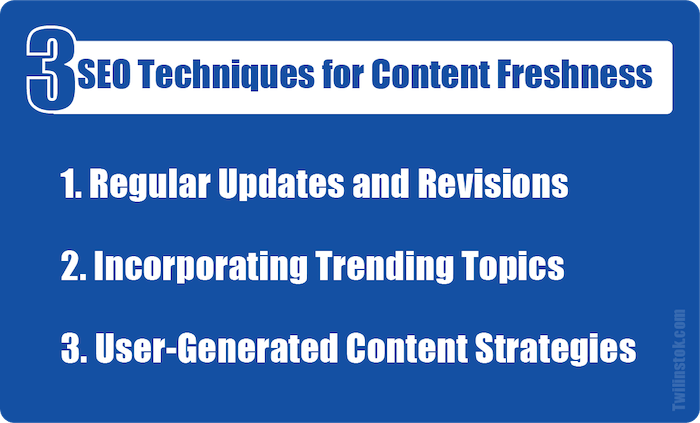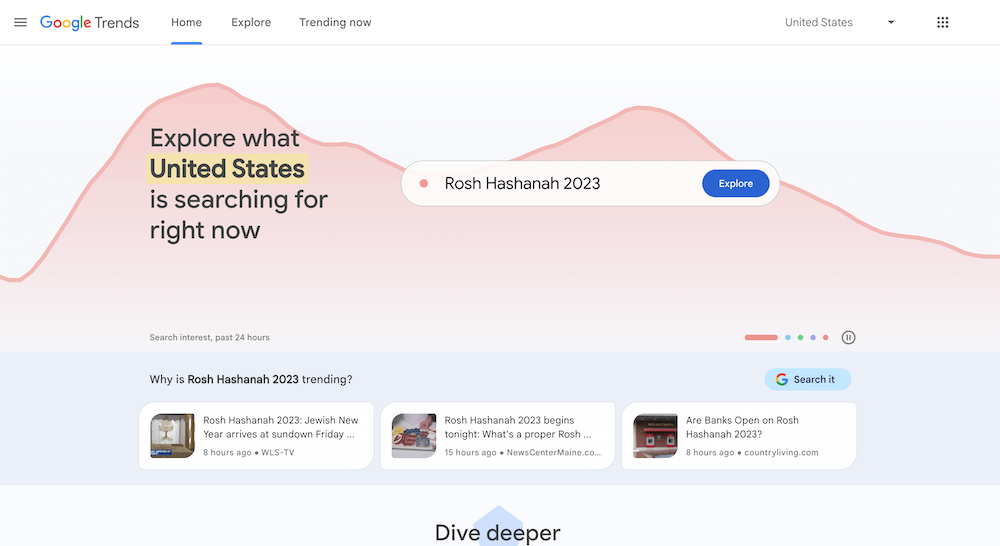Staying ahead of the curve is vital in the ever-evolving landscape of search engine optimization (SEO). It’s not just about optimizing your content; it’s also about keeping it fresh and relevant. Welcome to our comprehensive guide on “Content Freshness and SEO Examples,” where we’ll delve deep into the pivotal role that regularly updated and timely content plays in improving your website’s SEO performance. Join us in this article from Twilinstok, as we explore real-world SEO examples and strategies that illustrate the profound impact of content freshness on search engine rankings and user engagement. Whether you’re a seasoned SEO professional or just beginning your journey, this guide will provide you with actionable insights and tangible examples to enhance your content freshness strategies for SEO success.
Understanding Content Freshness
Before delving into SEO examples, let’s establish a clear understanding of what content freshness entails. Content freshness means regularly updating and revising your website’s content to reflect the latest information, trends, and user needs. It’s an ongoing effort to ensure that your content remains current, accurate, and engaging.
Is Fresh Content A Google Ranking Factor?
Absolutely, fresh content is indeed a Google ranking factor. While Google considers various elements when ranking web pages, content freshness is a critical aspect. Google’s algorithms recognize that up-to-date content is often more relevant and valuable to users. Therefore, when content is regularly updated or refreshed with new information, it can positively influence your website’s search engine rankings. This underscores the importance of incorporating content freshness as part of your SEO strategy, as highlighted in this article on “content freshness and SEO examples.”
Benefits of Fresh Content
Fresh content offers several advantages for your website’s SEO efforts. Firstly, it can significantly improve your search engine rankings. Search engines like Google prioritize recent and relevant content, so regularly updating your pages can lead to higher visibility in search results. Secondly, fresh content tends to be more engaging for users, leading to longer sessions and increased conversions. Lastly, it helps you stay ahead of competitors by demonstrating your expertise and commitment to providing valuable information.
SEO Techniques for Content Freshness
Achieving and maintaining content freshness requires specific strategies. These include regularly updating and revising existing content, incorporating trending topics and keywords, and leveraging user-generated content strategies. By following these techniques, you can ensure that your website remains an authoritative and up-to-date source in your niche.
- Regular updates and revisions
- Incorporating trending topics
- User-generated content strategies

Let’s delve into the SEO Techniques for Content Freshness with concrete examples for each of the techniques:
Regular Updates and Revisions
Keeping your existing content up-to-date is a fundamental strategy for maintaining content freshness. Search engines favor websites that provide accurate and current information. Here’s how you can implement this technique:
Incorporating Trending Topics
One effective way to inject freshness into your content is by incorporating trending topics or keywords relevant to your niche. By doing so, you demonstrate that your website is actively addressing current issues and user interests:
User-Generated Content Strategies
Engaging your audience to contribute content is another powerful way to maintain content freshness. Encourage users to participate by leaving comments, writing reviews, or even submitting guest posts. Here’s an example of how to use this strategy:
By implementing these techniques, you can ensure that your website’s content remains current, engaging, and valuable to both your audience and search engines. This proactive approach to content freshness can lead to improved SEO rankings and increased user satisfaction.
Real-World Content Freshness and SEO Examples
To illustrate the impact of content freshness on SEO, we’ll explore three real-world case studies:
Case Study 1: Boosting Rankings Through Content Updates
In this case, we’ll examine how a website significantly improves its search engine rankings by regularly updating and enhancing its existing content. We’ll explore the specific tactics used and the outcomes achieved. Let’s dive into that.
Business Type: Online Tech Magazine
In this case study, we’ll examine how an online tech magazine significantly improved its search engine rankings and user engagement by regularly updating and optimizing its content.
Background:
The online tech magazine specializes in providing in-depth reviews, how-to guides, and news articles related to the ever-evolving technology industry. Over the years, they accumulated a vast archive of articles on topics ranging from smartphone reviews to software tutorials. However, they noticed that some of their older content was losing visibility in search results, despite its quality.
Challenges:
- Dated Information: Many articles contained information that was no longer accurate due to technological advancements.
- Keyword Competition: The tech industry is highly competitive, making it challenging to rank for popular keywords.
- Declining Traffic: Older articles were receiving less organic traffic over time.
Strategy:
The magazine’s SEO team decided to implement a strategy focused on content freshness. They aimed to update, optimize, and republish existing articles to improve their rankings and user relevance. Here’s what they did:
- Content Audit:
The team conducted a thorough content audit, identifying articles that were outdated, had declining traffic, or had the potential for improvement. They categorized the content based on priority for updates.
- Keyword Research:
For each article slated for an update, extensive keyword research was performed to identify current trending keywords and search trends within the tech industry. They aimed to integrate these keywords naturally into the content.
- Content Refresh:
The articles were revisited, and outdated information was updated to reflect the latest developments in the tech world. New sections were added to include additional insights and fresh data.
- On-Page SEO Optimization:
The team optimized meta titles, descriptions, headings, and images for SEO. They also ensured that the content structure was user-friendly and easy to navigate.
- Republishing:
Once the updates were complete, the articles were republished with a new “Last Updated” date to indicate freshness.
Results:
The results of this strategy were remarkable:
- Improved Rankings: The updated articles began to climb the search engine rankings for their target keywords. Some even reached the top positions.
- Increased Organic Traffic: As the articles ranked higher, they started receiving more organic traffic, recapturing the attention of their audience.
- Enhanced User Experience: The fresh and relevant content provided users with up-to-date information, improving user satisfaction and reducing bounce rates.
This case study highlights the effectiveness of a proactive content freshness strategy. By continually revisiting and optimizing existing content, the online tech magazine not only regained lost traffic and rankings but also strengthened its authority in the tech niche. This example demonstrates the potential impact of content updates on SEO performance.

Case Study 2: Leveraging Trending Events for Freshness
This case study showcases how a website capitalized on trending events and topics to maintain content freshness. We’ll delve into the strategies employed and the resulting benefits. Let’s dive into that.
Business Type: News and Entertainment Blog
In this case study, we’ll explore how a news and entertainment blog capitalized on trending events and breaking news to maintain content freshness and attract a wider audience.
Background:
The blog focuses on delivering the latest news, celebrity updates, and entertainment content. However, they faced challenges in keeping their readers engaged due to the rapidly changing nature of the news and entertainment industry.
Challenges:
- Content Staleness: Blog posts often became outdated within days, leading to a decline in readership.
- Competitive Niche: The entertainment news niche is highly competitive, with numerous blogs vying for the same audience.
- Audience Engagement: The blog needed to find innovative ways to keep readers returning for fresh content.
Strategy:
To combat these challenges, the blog adopted a dynamic approach to content creation and freshness. Here’s how they leveraged trending events:
- Real-Time Monitoring:
The editorial team established a robust system for monitoring trending news and events in the entertainment world. This included using news aggregators, social media listening tools, and Google Trends.
- Rapid Content Creation:
Whenever a significant event or news story emerged, the team would quickly create well-researched and engaging articles. They focused on providing unique angles, exclusive interviews, and behind-the-scenes insights.
- SEO Optimization:
While speed was crucial, they also paid attention to SEO. They incorporated relevant keywords, optimized meta descriptions, and used concise, informative titles.
- Multimedia Integration:
To enhance the content’s appeal, they incorporated multimedia elements like videos, images, and infographics, making the stories visually engaging.
- Social Media Promotion:
The blog used social media platforms to promote their fresh content, leveraging trending hashtags and engaging with their audience.
Results:
The results of this strategy were outstanding:
- Increased Traffic: By consistently covering trending events, the blog attracted a larger and more engaged readership.
- Improved Rankings: Their SEO efforts paid off, as their articles started ranking higher for relevant keywords.
- Enhanced Brand Authority: Readers began to see the blog as a reliable source for up-to-the-minute entertainment news.
- Sustained User Engagement: The dynamic approach kept readers coming back for fresh content, reducing bounce rates and increasing time on site.
This case study demonstrates how staying on top of trending events and adapting content quickly can lead to sustained content freshness and SEO success. For news and entertainment blogs, leveraging trending topics is a powerful strategy to maintain relevance and grow their audience.

Case Study 3: Engaging Users for Consistent Freshness
Here, we’ll examine how a website successfully engages its users in contributing fresh content. We’ll explore user-generated content strategies and their positive impact on SEO. Let’s dive into that.
Business Type: Online Forum and Community
This case study explores how an online forum and community platform managed to maintain content freshness by actively involving its user base in generating new discussions, questions, and user-generated content (UGC).
Background:
The online forum focused on a niche topic related to technology and gadgets. While they had a dedicated user base, keeping the platform’s content fresh and engaging was a constant challenge.
Challenges:
- Content Stagnation: Threads and discussions often became stale, leading to a drop in user activity.
- User Engagement: Encouraging users to participate actively and initiate new discussions was challenging.
- Search Engine Visibility: The forum needed to improve its SEO efforts to attract new members and discussions.
Strategy:
To address these challenges, the forum adopted a strategy that empowered its users and encouraged them to generate fresh content:
- Gamification:
The forum introduced a gamified system where users earned points, badges, and recognition for creating new threads, posting replies, and generating valuable discussions. This incentivized users to contribute actively.
- Topic Prompts and Challenges:
Regularly, the forum introduced topic prompts and challenges related to current trends, news, or tech developments. These challenges encouraged users to share their opinions and insights.
- User-Generated Content Contests:
The forum organized UGC contests, where users could submit articles, reviews, or tutorials related to the niche. Winning entries were featured prominently.
- User Moderators:
Experienced and active users were given the role of moderators, responsible for initiating discussions and ensuring the forum’s guidelines were followed.
- SEO Optimization:
The forum paid attention to SEO by optimizing thread titles, and meta descriptions, and ensuring that discussions were discoverable through search engines.
Results:
Implementing these strategies resulted in significant improvements:
- Increased User Activity: User participation soared as they competed for badges and recognition.
- Abundant Fresh Content: New discussions and threads became a regular occurrence, reducing content stagnation.
- Enhanced SEO Visibility: The forum started ranking higher on search engines for niche-specific keywords.
- Community Growth: The forum attracted new members who were enticed by active discussions and engaging content.
This case study demonstrates how involving users in content creation can be a powerful strategy for maintaining content freshness, especially for community-based platforms. By ganifying participation and encouraging user-generated content, the forum ensured a steady influx of fresh discussions and SEO benefits.

Measuring Freshness Impact
In the world of SEO and content marketing, measuring the impact of freshness is paramount to assess the effectiveness of your efforts. It allows you to understand how content updates and timely additions affect your website’s performance, rankings, and user engagement.
Key Metrics to Monitor
- Organic Traffic: Track the increase or decrease in organic traffic to your web pages following content updates. Tools like Google Analytics and Google Search Console can provide valuable insights into this metric.
- Keyword Rankings: Regularly check the rankings of target keywords for your updated content. An improvement in rankings can indicate that freshness positively impacts SEO.
- Bounce Rate: Analyze whether updated content leads to a reduction in bounce rates. Lower bounce rates suggest that users find the updated content more engaging and relevant.
- Time on Page: A longer average time spent on a page can indicate that users are finding the updated content valuable and informative.
- Click-Through Rate (CTR): Assess whether updated meta titles and descriptions lead to an increase in CTR from search engine results pages (SERPs). An improved CTR can result in higher organic traffic.
- Conversion Rate: For pages with conversion goals (e.g., sign-ups, and purchases), measure whether freshness impacts the conversion rate positively or negatively.
Tools for Measurement
- Google Analytics: Provides data on traffic, user behavior, and conversions, helping you assess the impact of freshness on user engagement.
- Google Search Console: Offers insights into search performance, click-through rates, and keyword rankings, crucial for monitoring SEO impacts.
- SEMrush and Ahrefs: These SEO tools can track keyword rankings and provide competitive analysis, aiding in measuring the impact of freshness in relation to competitors.
- Heatmap and User Behavior Tools: Tools like Hotjar and Crazy Egg can help visualize user interactions on your pages, including how far users scroll and where they click, offering insights into content engagement.
Case Studies and Examples
- Consider conducting A/B tests where you update one piece of content and leave another unchanged. Compare the metrics mentioned above to assess the impact of freshness.
- Look for industry case studies that showcase how content freshness led to improved SEO performance, increased traffic, or enhanced user engagement.
- Implement an ongoing content update strategy, and over time, measure the collective impact on organic traffic and other key metrics.
Conclusion
As we wrap up our exploration of “Content Freshness and SEO Examples,” it’s evident that keeping your content up-to-date is no longer optional in the realm of SEO. It’s a necessity that can significantly impact your website’s performance in search engine rankings and user engagement. By regularly refreshing your content, leveraging trending events, and engaging with your audience, you’re taking crucial steps toward staying competitive and relevant in the online world.
The case studies we’ve examined serve as real-world proof of the potency of content freshness in SEO. They highlight how businesses across various industries have achieved remarkable results by prioritizing the regular updating of their content.
So, whether you’re a content creator, marketer, or business owner, remember that content freshness and SEO examples are the dynamic duos that can set you apart in the digital landscape. By implementing the techniques and strategies outlined in this guide, you’re well on your way to optimizing your content for both search engines and your target audience.
Stay fresh, stay relevant, and keep harnessing the power of “content freshness and SEO examples” to propel your online presence to new heights. It’s a journey worth embarking on for long-lasting SEO success.
For more information about Search Engine Optimization, we suggest that you click on Free SEO Tutorial [+]. Also, if you have any questions about SEO, you can ask them in our SEO support center [+] in the form of a topic and wait for the answer of our experts.
FAQs on Content Freshness and SEO
How often should I update my content for SEO?
The frequency of updates depends on your niche and audience. For some, weekly updates are necessary, while others may require monthly or quarterly refreshes.
Can user-generated content improve freshness?
Yes, involving users in content creation can enhance freshness. Encourage comments, reviews, and contributions to keep your content up to date.
What tools can help monitor content freshness?
Tools like Google Analytics, SEMrush, and Ahrefs provide insights into your content’s performance and freshness.
Are there risks to frequent content updates?
While updates are beneficial, be mindful of maintaining content quality. Frequent changes without added value can negatively impact user experience.
How can I maintain content relevance over time?
Continuously research and adapt to industry trends, monitor user feedback, and seek opportunities to enhance your content based on evolving needs.

